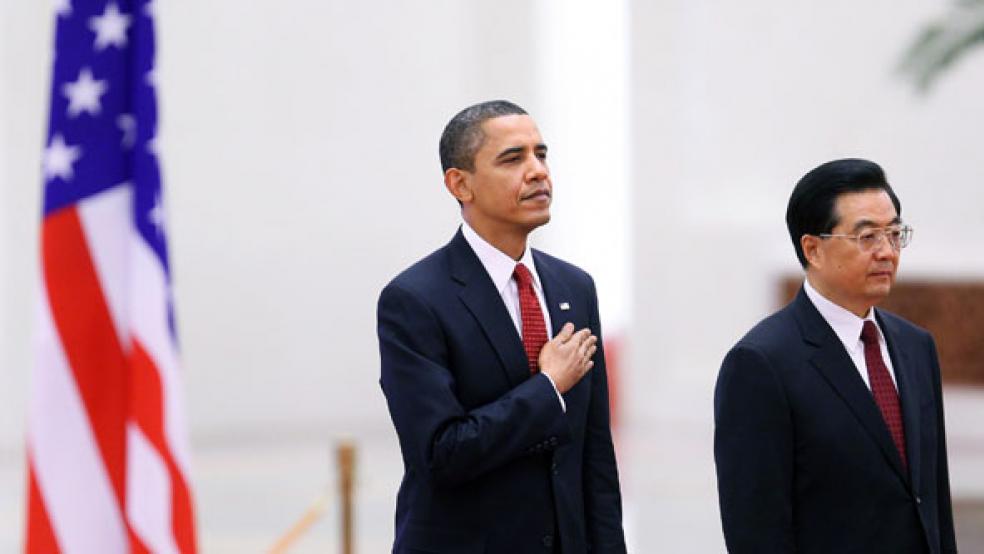DaSol Solar, a mid-sized Chinese solar panel manufacturing company, recently opened a small office in suburban Washington, D.C., to scout out business opportunities in the U.S. Although most of its solar panels for street lighting and off-the-grid houses are sold in East Asia and Africa, the Zhejiang province-based firm sees an unmet need here for applications unique to western markets — like small rooftop solar cells to run attic fans.
“We think the U.S. market will be a great opportunity for us,” said Elissa Wang, the local manager for DaSol, whose office is located in an international business incubator funded by the state of Maryland. The company may even one day manufacture here. “It will depend on demand. If we see the benefit, we would consider it,” she said.
The tiny investment by DaSol, and the prospect that it could grow into something larger, is part of a quiet evolution of Chinese investment in the United States — a topic of heightened interest this week as Chinese President Hu Jintao meets with President Obama in Washington to discuss U.S.-China cooperation on economic, trade and global issues. At first, China invested the hard currency earned through trade surpluses, which are now running about $230 billion a year in U.S. treasury bonds. Then the focus of investment shifted to strategic assets like energy and minerals in a calculated campaign by China’s state-run enterprises to buy stakes in firms that could guarantee them access to commodities critical to their continued rapid economic growth.
firms and banks have made large investments
in U.S. car companies, like General Motors’ IPO.
But in the past few years, the world’s second largest economy has begun moving its mammoth foreign exchange earnings into investment activities traditionally pursued by any country running chronic trade surpluses. China’s sovereign wealth fund and its state-run firms and banks have made large investments in U.S. car companies, like General Motors’ initial public offering.
They helped bail out the U.S. banking sector in 2008. More recently, Chinese capital has plunged into the U.S. real estate market. In a move reminiscent of Japan’s purchase of Rockefeller Center in the late 1980s, they’ve made investments in prestige New York City properties like 650 Madison Avenue, home to the headquarters of Polo Ralph Lauren Corp., and a lower Manhattan tower once owned by AIG.
will be a fairly long process.”
And, in response to a strengthening yuan (renminbi), which has appreciated about 10 percent in the past year if one includes the difference between the China and U.S. inflation rates, some firms whose business depends on access to the U.S. market have begun setting up shop here. Their goal is to be closer to their end users, which ultimately could lead, as it did with Japanese manufacturers in the 1980s and 1990s, to these firms designing or even building products here that were previously made in China.
“We are currently going through a historic inflection point with respect to Chinese investment in the U.S.,” said Daniel H. Rosen, a principal at the Rhodium Group, a New York investment advisory firm. “It is a broad-based move across a broad swath of the economy — not just energy assets.”
Total Chinese investment in the U.S. remains small and is just a fraction of the holdings by firms based in the United Kingdom, Germany and France. But it is growing rapidly, and will accelerate if U.S. policymakers succeed in their efforts to convince the Chinese government to allow faster appreciation of the yuan. With the U.S. economy mired in a sluggish recovery, currency values will be a major focus of talks this week between Obama and Hu. Don’t look for major breakthroughs in the talks, though. Hu, in an exclusive written interview granted to the Wall Street Journal and Washington Post, rebuffed calls for an openly-traded renminbi or yuan, which would lead to its rapid appreciation vis-à-vis the dollar and reduce trade frictions between the two countries. “Making the RMB an international currency will be a fairly long process,” he wrote.
by just $5 billion last year,
up from $1.8 billion in 2009. That’s barely a ripple
in a $14 trillion domestic economy.
A stronger yuan makes Chinese exports to the U.S. more expensive and cheapens the yuan price of U.S. exports. Both trends would improve the job prospects for U.S. workers. It also devalues — in yuan terms — China’s $1 trillion-plus stock of U.S. government bonds. That depreciation creates a huge incentive to seek out alternative investments, according to experts.
While jobless Americans might welcome increased Chinese investment here, China’s non-financial asset holdings in the U.S. increased by just $5 billion last year, up from $1.8 billion in 2009. That’s barely a ripple in a $14 trillion domestic economy.
The level could rise quickly, though, if the yuan appreciates, just as Japanese investment did after the 1985 Plaza Accord that raised the value of the yen. “The total stock of Chinese foreign direct investment is tiny compared to other countries,” said Edwin Truman, a senior fellow at the Peterson Institute for International Economics. “But that doesn’t mean it will be that way forever.” (The research institute is funded by Peter G. Peterson, who also finances The Fiscal Times.)
cyber capability and any potential vulnerability
within or threat to DOD networks.”
The U.S. is already becoming a destination of choice for Chinese firms looking to invest abroad. According to the Heritage Foundation’s Global Chinese Investment Tracker, the total stock of Chinese investments in the U.S. now totals $28.1 billion, making it the second leading destination for Chinese capital behind Australia.
The pace of China Inc.’s investment in the U.S. has been held back by national security concerns. In 2005, the attempt by CNOOC, a publicly-traded Chinese oil company, to buy California’s Unocal for $18.5 billion collapsed after Congress complained that it would lead to Chinese control of U.S. oil supplies.
Last fall, Sprint Nextel excluded two Chinese firms — Huawei Technologies, a rapidly growing telecommunications equipment company started by a former Chinese military officer, and ZTE Corp., a spin-off from state-owned firms — from bidding on a $5 billion to $7 billion contract to modernize its communications network. U.S. Commerce Secretary Gary Locke and the Department of Defense told Sprint they might look unfavorably on the deal. The interagency Committee on Foreign Investment in the U.S. reviews pending deals involving “critical technologies,” and has the power to veto any transaction that might have national security implications.
“DOD is very concerned about China’s emerging cyber capability and any potential vulnerability within or threat to DOD networks,” the Pentagon told the Wall Street Journal, which first reported the story. Winning the contract would have led to some investment in the U.S., since Huawei had teamed up with a consultant company founded by William Owens, a former vice chairman of the U.S. Joint Chiefs of Staff, and Amerilink Telecom of Overland Park, Kansas.
Recent deals in the energy sector — a major concern for the Chinese government since it has limited domestic oil and gas resources — have been significantly smaller than the CNOOC fiasco and seemed more geared toward maximizing China’s return on investment than tying up strategic resources. Last fall, the government’s China National Oil Co. purchased a one-third stake in Chesapeake Energy’s shale oil and gas fields in south Texas for $1.1 billion. And in late 2009, China’s sovereign wealth fund, the China Investment Corp., invested $2.2 billion in AES, an Arlington, Va.-based utility company, in exchange for 15 percent of its stock and a third of its new wind-power business.
“I’m in favor of Chinese investment in steel and autos, said Derek Scissors, the senior fellow at the Heritage Foundation who tracks Chinese investments in the U.S. “Let them have Chrysler, but not advanced technology.”
going to do it in China because
that’s where the practitioners are.”
If there’s one area where China is making strategic investments, it is in energy technologies geared toward reducing carbon emissions, which are likely to become a huge growth market in the next decade as global warming accelerates. New data released last week by the National Aeronautics and Space Administration, and the National Oceanic and Atmospheric Administration showed 2010 tied 2005 as the hottest year ever, and the past decade was the hottest since the government began tracking global temperatures.
China has used all the tools of government-led industrial policy that were pioneered in East Asia to promote its green technology industries, including low-cost government loans and subsidized end markets. U.S.-based Evergreen Solar cited the Chinese government’s subsidization of its solar industry in announcing last week that it would close its 800-employee solar manufacturing plant in Devens, Mass., just two years after the state offered $58 million in taxpayers subsidies to build the facility. Evergreen also has a factory in Wuhan, China, a joint venture with Jiawei Solarchina Co. that received cash infusions from a Chinese government investment fund.
“Solar, wind, coal gasification, gas — the U.S. doesn’t win on any of them,” Jeffrey Immelt, the chief executive officer of General Electric, told a forum on innovation held at the Brookings Institution last week. “GE is going to invest in carbon sequestration, but we’re going to do it in China because that’s where the practitioners are.”
But that doesn’t mean the Chinese companies that are taking the lead in developing advanced technologies to reduce greenhouse emissions — like China’s DaSol — won’t find a willing market here. “Renewable energy is inevitable — it’s not if but when,” said Scott Sklar, president of the Stella Group, a solar industry consulting firm and past president of the Solar Industry Manufacturers Association. “The Chinese are betting that they will be in the best position when the renewable market takes off, which it has begun to do.”
And for many Chinese firms, that means investing here, even as some U.S. firms like Evergreen are cutting back. China’s SunTech Power a year ago announced plans to build a $10 to $15 million plant employing up to 250 workers near Phoenix to serve the growing U.S. demand for solar cells.
“We’re not a bad manufacturing country,” Immelt said. “When it comes to a solar plant, labor is a pimple on the cost of a product.” What the U.S. lacks are the practitioners, the government support and the investment capital — things China has in abundance and is beginning to invest in the U.S. Immelt may be right. Last week Evergreen Solar, the Massachusetts-based solar panel manufacturer announced it was closing its U.S. factory, laying off 800 workers and moving its operation to China.
Related Links:
China Syndrome: A Strong Trade Policy Levels the Field (The Fiscal Times)
Geithner Prods China on Currency Policy (The Washington Post)







